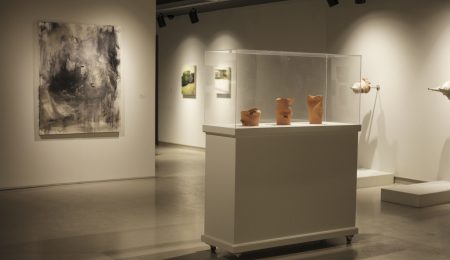Mackenzie Valley pipeline revisited through portraits and interviews
Photo courtesy of Linda MacCannell
“If you want to have a political debate, this is a good place to do it, ” said Drew Ann Wake.
An art exhibit exploring the landmark 1977 Berger Inquiry into the building of the Mackenzie River Valley River Pipeline is coming to the University of Ottawa. Wake, a former CBC reporter who covered the inquiry, curates the exhibit that tells the story of 32 Dene, Inuvialuit, and non-Aboriginal stakeholders who lived along the path of the proposed pipeline.
In her eyes, the exhibit invites attendees “to negotiate the issues, debate with each other, and come to some resolution.”
The show uses numerous audiovisual tools, many of which Wake obtained while covering the inquiry to give a strong historical context to the exhibit.
“I stumbled across my cache of audio tapes and I had about 150 hours and my colleague, Michael Jackson, who was the special council at the inquiry, had a collection of about 1,000 slides that he had taken during the community hearings,” said Wake. “We thought we could put the slides together with the audio so people could get a sense of what the inquiry was like.”
Wake, Jackson, and Calgary photographer Linda MacCannell travelled through the Yukon and Northwest Territories to show the exhibit to the communities who fought to stop the pipeline 30 years ago. The first town was Nahanni Butte, N.W.T., where nearly the entire community of 120 people came out to see the exhibit at the local school.
“I walked down toward the school at seven o’clock at night. I could see the lights coming from all parts of the village and there were all-terrain vehicles and people were driving the elders, who had been alive at the time of the inquiry,” said Wake. “The elders all started to tell their stories of when they spoke to Judge Berger. So that’s when we realized that this was going to be a huge success for the people in the communities.”
The exhibit continued its trip down the Mackenzie River, stopping in 25 communities where people shared their experiences, which Wake and MacCannell added to the latest version of the exhibit. Life-sized photos of affected community members taken by MacCannell and interviews conducted by Wake are now the cornerstone for what people can expect from the exhibit as it comes to the U of O from Feb. 3–7.
Wake designed the exhibit to be interactive and to appeal to both an artistic and academic audience, helping to spur discussion from multiple perspectives.
“The exhibit functions two ways. You can come and treat it like an art gallery exhibit with the portraits, but if you come with your class or with your family, you can sit down at one of the tables and the tables will have the stories from four people, who hold completely different points of view.”
Not only does the exhibit discuss the themes of the Berger Inquiry, but Wake also feels it brings out debates over other pipeline project issues like Keystone XL and Northern Gateway.
“We find that the exhibit triggers a contemporary debate as well,” he said. “It’s very common that people start debating the current pipeline proposals when they attend the exhibition.”
The “Mackenzie River Pipeline Inquiry” exhibit private viewing takes place Feb. 3 from 2:30 p.m. to 5:30 p.m. in Fauteux Hall Room 550. Wake will be speaking, leading discussion, and taking questions about the exhibit. The event is free and refreshments will be served.





